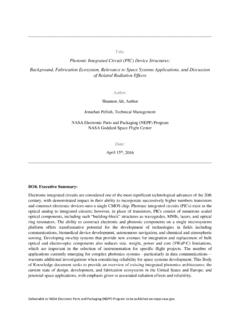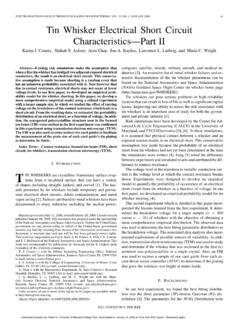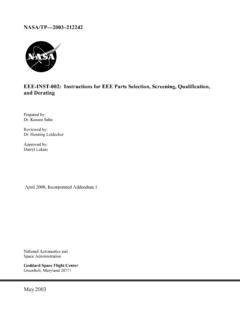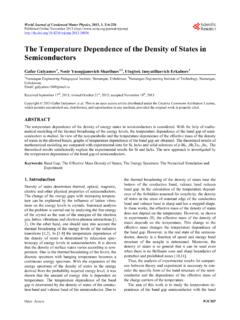Transcription of Temperature Dependent Dielectric Properties of ...
1 Temperature Dependent Dielectric Properties of polycrystalline 96%Al2O3 Liang-Yu Chen1 and Gary W. Hunter2 1 Ohio Aerospace Institute/NASA Glenn Research Center at Lewis Field, Cleveland, OH 44135 2 NASA Glenn Research Center at Lewis Field, Cleveland, OH 44135 Abstract polycrystalline Al2O3 substrates have been proposed and tested for high Temperature micro devices packaging intended for operation at temperatures up to 500oC. The Dielectric Properties of this material, including Dielectric constant and effective volume conductivity, at elevated temperatures are of interest, especially for RF packaging applications. This article reports Temperature Dependent Dielectric Properties of polycrystalline 96% Al2O3 substrates from room Temperature to 550oC measured by the AC impedance method at 120 Hz, 1 kHz, 10 kHz, 100 kHz, and 1 MHz.
2 We observed negative Temperature coefficients of volume electrical conductivity of 96% Al2O3 at 1 k, 10 k, and 100 kHz between room Temperature and 50oC. The Dielectric constant of the material increases significantly with Temperature at frequencies below 10 kHz. The physical mechanisms of these Dielectric behaviors of 96% Al2O3 at elevated temperatures are discussed. Introduction polycrystalline aluminum oxide (Al2O3) is an important packaging substrate material which has low cost, high thermal stability, and high electrical resistivity. It has been extensively used in high reliability electronics packaging. Various thin-film and thick-film metallizations have been developed for Al2O3 substrates. In addition to conventional electronics packaging, Al2O3 has also been proposed for high Temperature electronic devices and high Temperature MEMS packaging [Salmon, 1998 and Chen 2002].
3 The packaging applications in elevated Temperature environments, especially, those for high Temperature radio frequency (RF) devices [Hunter, 2003, Spry and Neudeck, 2004] generated interests in the Temperature dependence of Dielectric constant and volume electrical conductivity of Al2O3 substrates. Limited data of Temperature Dependent Dielectric Properties of Al2O3 have been reported previously [Antula 1967]. In this article we report Temperature and frequency Dependent Dielectric Properties of polycrystalline 96% Al2O3 substrates in a Temperature range from room Temperature to 550oC measured by the AC impedance method at 120 Hz, 1 kHz, 10 kHz, 100 kHz, and 1 MHz. Experimental Details The room- Temperature Dielectric constant of polycrystalline 96% Al2O3 has been reported to be between 1 k and 100 MHz, and room Temperature dissipation factor has been reported to be at 1 kHz, at 1 MHz, and at 100 MHz [MetWeb].
4 A capacitor for measuring Temperature Dependent Dielectric Properties of 96%Al2O3 substrate was fabricated on a in. x in. x mil 96%Al2O3 substrate (used as the Dielectric ) with gold (Au) thick-film metallization (used as the two electrodes) on both sides of the substrate. The surface roughness of the substrate was ~ 20 microinch (rms). The electrode/metallization area was in. x in. at the center region of the substrate. The Au thick-film material was screen-printed and cured at 850oC in air. The rest of the Al2O3 surface areas (half inch wide surrounding the Au metallization areas) was passivated with thick-film glass in order to reduce surface electrical conductivity which can depend on environmental humidity, especially, at high temperatures . Au wires were bonded onto the Au electrodes (metallization) areas to electrically connect the capacitor with measuring instruments via 1 m long coaxial cables.
5 The capacitor was thermally soaked in a box oven in which the Temperature was controlled to an accuracy of 2oC during the experiment. Prior to data acquisition, the capacitor was first heated in 500oC air ambient for 72 hours. The AC impedance of the Al2O3 capacitor was measured by an AC impedance meter. 1 V (rms) sinusoidal voltage at frequency f (or angular frequency f = 2, f = 120 Hz, 1 kHz, 10 kHz, 100 kHz, and 1 MHz) was applied to the capacitor . The amplitude and the relative phase shift of the response current through the capacitor were measured to construct a complex impedance (or admittance) at frequency f. The capacitor was electrically modeled as a parallel circuit composed of an ideal capacitor (without parasitic self-inductance and conductance) for polarization current (with -90o phase shift) and an ideal resistor (without parasitic capacitance and self-inductance) for conduction and Dielectric loss current (with 0o phase shift).
6 The Dielectric constant of Al2O3 is calculated from the capacitive imaginary part of the admittance at frequency f, and effective AC conductivity of Al2O3 is calculated from the real part of the admittance. With this linear parallel circuit model, the measured complex AC admittance, Y, at frequency f is a linear function of the relative Dielectric constant, , and AC effective volume conductivity, eff : (1) where o is vacuum Dielectric constant, T is Temperature , A is electrode area, and d is the parallel electrodes separation distance (thickness of the Al2O3 dielectrics). Since dA>>2/1 the boundary effects at metallization edges can be approximately ignored. CTCoo55023 in this experiment, and == 2/f 120 Hz, 1 kHz, 10 kHz, 100 kHz, and 1 MHz depending on the setup of the impedance meter. Both DC leakage and the Dielectric loss of the media in AC electric field are included in ),( Teff.
7 0,(= Teff is the DC conductivity. Typically, eff decreases with Temperature for good conductors such as metals, while it increases with Temperature for good insulators such as ceramics. Both the Dielectric constant and the effective volume conductance of the Dielectric (96% Al2O3 in our case) can be directly calculated from the measured AC admittance through Equation 1. One of the basic assumptions for measuring the Dielectric constant and conductivity of a capacitor device using a parallel RC circuit model is that, in the range of the input voltage signal, the device is linear. Non-linearity may cause significant unexpected measurement error. The linearity of DC leakage of the capacitor device dATjdATTY oeff/),(/),(),( +=within V at various temperatures was examined by DC current voltage (I-V) measurements.)
8 Results and Discussion Figure 1a shows the plots of the relative Dielectric constant, ),(' T, of the polycrystalline 96%Al2O3 sample versus Temperature at various frequencies. Below 200oC, ' changes very little with Temperature at all five frequencies. Above 200oC, ' increases monotonically with the Temperature , and the Dielectric constant increases more rapidly with Temperature at lower frequencies. At 120Hz, ' at 550oC is about times of that at room Temperature . In contrast, at 100 kHz and 1 MHz, with the Temperature increase from room Temperature to 500oC ' increases only and , respectively. Figure 1b shows frequency Dependent ' at various temperatures . Temperature affects ' more at lower frequencies below 100 kHz. The inset of Figure 1b shows detailed variations of ' between 10 kHz and 1 MHz at various temperatures .
9 At temperatures below 250oC, ' does not change much in the whole frequency range. This type of frequency dependence is typical. The higher measured Dielectric constant at low frequencies is caused by displacement of quasi-free charge carriers which are thermally excited at elevated Temperature [Bartnikas et al., 1983]. These quasi-free charge carriers respond to external field but statistically do not get neutralized with charges from external sources, therefore, resulting in phenomenal polarization current in response to external fields. The quasi-free charge carriers excited/activated at high Temperature are most likely from impurities/dopants used to control the grain sizes of Al2O3 ( Dielectric constant of 90% Al2O3 measured at elevated temperatures were found to be tremendously high [Chen et al.)]
10 , 2005]). Figure 1: Temperature and frequency Dependent Dielectric constant of 96%Al2O3 substrate. Figure 2a shows effective volume conductivity ),( Teff as a function of Temperature at various frequencies. Between 23oC and 50oC the effective AC conductivity at 1 kHz, 10 kHz, and 100 kHz decreases slightly with Temperature showing negative Temperature coefficients. A negative Temperature coefficient of the conductivity is not usual for insulator materials suggesting interesting thermal effect(s) on AC 8131823281001000100001000001000000 Frequency (Hz)Relative Dielectric Constant550C500 C450 c400 C350 C300 C250 C200 C150 C100 C50 C23 (C)Relative Dielectric Constant1 MHz100 KHz10 KHz1 KHz120 Hzabconductivity of 96% Al2O3 between 23 and 50oC. Above 100oC, volume conductivity increases monotonically and rapidly with Temperature .














![C = Q/ T = dQ/dT [J/deg] - University of Virginia](/cache/preview/a/f/5/8/1/b/f/3/thumb-af581bf37b8258665c1595c6c7b2f7a3.jpg)




